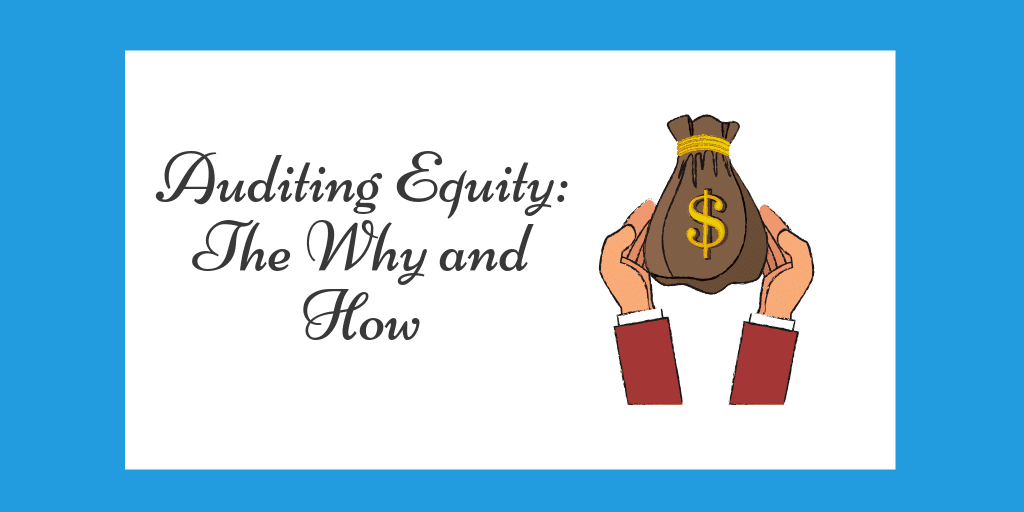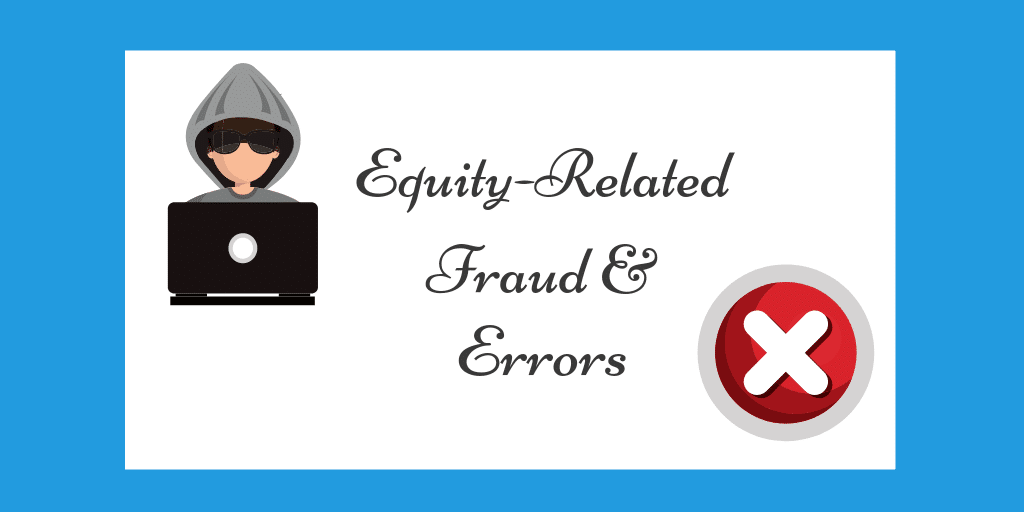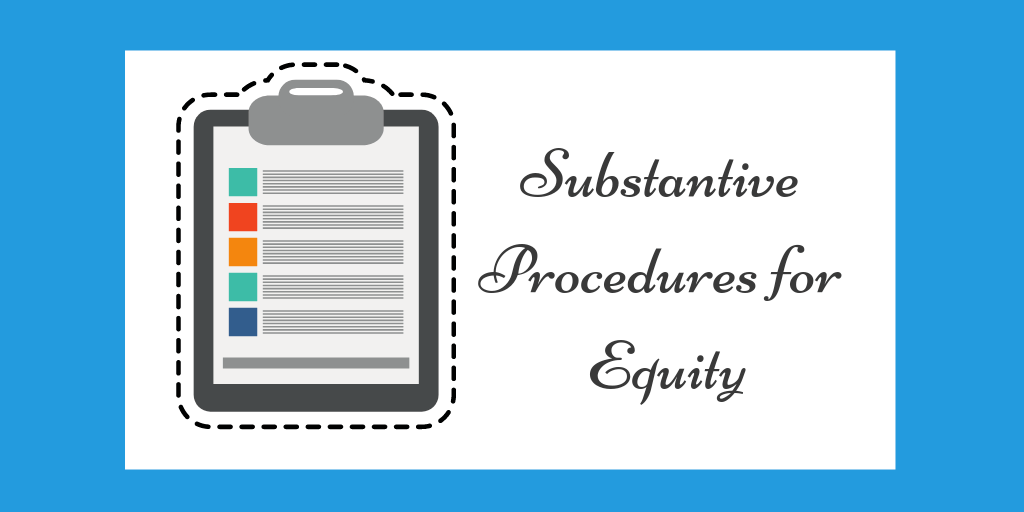Auditing equity is easy, until it’s not.
Auditing equity is usually one of the easiest parts of an audit. For some equity accounts, you agree the year-end balances to the prior year ending balance, and you’re done. For instance paid-in-capital seldom changes. Often, the only changes in equity are from current year profits and owner distributions. And testing those equity additions and reductions in equity takes only minutes.
Nevertheless, auditing equity can be challenging, especially for businesses that desire to attract investors. Such companies offer complicated equity instruments. Why? The desire to attract cash without giving away (too much) power. And this balancing act can lead to complex equity instruments.
Regardless of whether a company’s equity is easy to audit or not, below I show you how to focus on important equity issues.
Auditing Equity — An Overview
In this post, we will cover the following:
- Primary equity assertions
- Equity walkthroughs
- Equity-related fraud and errors
- Directional risk for equity
- Primary risks for equity
- Common equity control deficiencies
- Risk of material misstatement for equity
- Substantive procedures for equity
- Common equity work papers
More...
Primary Equity Assertions
Before we look at assertions, consider that equity comes in a variety of forms including:
- Common stock
- Paid in capital
- Preferred stock
- Treasury stock
- Accumulated other comprehensive income
- Noncontrolling interests
- Members’ equity (for an LLC)
- Net assets (for a nonprofit)
- Net position (for a government)
Certain types of equity accounts are used for certain types of entities. For example, you’ll find common stock in an incorporated business, net assets in nonprofits, and members’ equity in a limited liability corporation.
The equity accounts used depend upon the type of entity and what occurs within and outside the organization. Examples include:
- Has an incorporated company purchased treasury stock?
- Does a commercial entity have unrealized gains or losses on available-for-sale securities?
- Does a nonprofit organization have donor-restricted contributions?
- Does a government have restricted net position?
So, it’s a must--before you determine the relevant assertions--that you understand the accounting for (1) the type of entity and (2) the particular equity-related transactions.
Primary relevant equity assertions include:
- Existence and occurrence
- Rights and obligations
- Classification
When a company reflects equity on its balance sheet, it is asserting that the balance exists and that the equity transactions occurred. For example, if common stock is sold, the balance of the account is based upon the actual sale of stock and the monies received. In other words, the balance is not fraudulently or erroneously stated.
Equity instruments also have certain rights and obligations. For example, common stock provides rights to retained earnings. Also, some classes of stock provide voting privileges. Others do not.
Additionally, the classification of equity balances is important. Determining how to present equity is usually easy, but classification issues arise when an entity has convertible stock (is it debt or equity?). Another example of a classification issue is noncontrolling interests (how much of the profits go to this account?).
Keep these assertions in mind as you perform your transaction cycle walkthroughs.
Equity Walkthroughs
Early in your audit, perform a walkthrough of equity to see if there are any control weaknesses. As you perform this risk assessment procedure, what questions should you ask? What should you observe? What documents should you inspect? Here are a few suggestions.
Auditing Equity Questions
As you perform your equity walkthrough ask or perform the following:
- What types of equity does the entity have? What are the rights of each class?
- How many shares are authorized? How many shares have been issued?
- Does the company have any convertible debt?
- Has the company declared and paid dividends?
- Are there any state laws restricting distributions?
- Does the company have accumulated other comprehensive income?
- Inspect ownership documents such as stock certificates.
- Read the minutes to determine if any new equity has been issued.
- Is the entity attempting to raise additional capital?
- Has the company sold any additional equity ownership?
- Is there a noncontrolling interest in the company?
- Does the company have stock compensation plan?
- For a nonprofit, are there any restricted donations?
- For a government, is the net position restricted?
- For a limited liability corporation, are there differing classes of ownership?
As you ask the above questions, consider examining equity-related information such as stock certificates, receipts from new equity issuances, general ledger accounts, related journal entries, minutes, and stock compensation plan documents. Don’t just ask questions. Observe equity controls (see below) and inspect sample documents.
As you perform walkthroughs, also consider if there are risks of material misstatement due to fraud or error.
Equity-Related Fraud and Errors
Theft seldom occurs in the sale of stock. If fraud happens, it’s usually a false equity presentation. Why? Inflating equity makes the organization appear healthier than it really is.
Additionally, mistakes lead to errors in equity accounting. Such mistakes might occur if the entity sells complex equity instruments.
So, what is the greater risk for equity? An overstatement or an understatement?
Directional Risk for Equity
The directional risk for equity is that it is overstated (companies desire strong equity positions). So, audit for existence.
Primary Risks for Equity
Primary risks for equity include:
- Equity is intentionally overstated (fraud)
- Misclassified equity (error)
As you think about these risks, consider the control deficiencies that allow equity misstatements.
Common Equity Control Deficiencies
In smaller entities, it is common to have the following control deficiencies:
- One person performs two or more of the following:
- Approves the sale of equity interests,
- Enters the new equity in the accounting system,
- Deposits funds from the sale of the equity instruments
- Accounting personnel lack knowledge regarding equity transactions
Another key to auditing equity is understanding the risks of material misstatement.
Risk of Material Misstatement for Equity
In auditing equity, the assertions that concern me the most are existence, classification, and rights. So my risk of material misstatement for these assertions is usually moderate to high.
My response to the higher risk assessments is to perform certain substantive procedures: namely, a review of equity transactions. Why?
A company may desire to overstate its equity. Also, misclassifications occur due to misunderstandings about equity accounting.
Once your risk assessment is complete, you’ll decide what substantive procedures to perform.
Substantive Procedures for Equity
My normal substantive tests for auditing equity include:
- Summarizing and reviewing all equity transactions
- Reviewing all equity accounts for proper classification
- Agreeing all beginning of period balances to the prior period’s ending balances
- Reviewing equity disclosures for compliance with the requirements of the reporting framework (e.g., GAAP)
In light of my risk assessment and substantive procedures, what equity work papers do I normally include in my audit files?
Common Equity Work Papers
My equity work papers normally include the following:
- An understanding of equity-related internal controls
- Documentation of any equity internal control deficiencies
- Risk assessment of equity at the assertion level
- Equity audit program
- A copy of (sample) equity instruments
- Minutes reflecting the approval of new equity or the retirement of existing equity
- A summary of equity activity (beginning balances plus new equity less equity distributions and ending balance)
In Summary
In summary, we’ve reviewed the keys to auditing equity. Those keys include risk assessment procedures, determining relevant assertions, performing risk assessments, and developing substantive procedures. The most important issues to address are usually (1) equity accounting (especially when there are more complex types of equity transactions) and (2) the classification of equity.
Now that we’ve reviewed the audit of transaction areas, it's time to shift gears. Next we'll look at how to wrap up the audit.
Audit Series
This post concerning how to audit equity is one of several articles in my audit series: The Why and How of Auditing.




Yes, Ed. It’s easily overlooked. I think we can go on automatic pilot sometimes forget about key considerations in equity. I saw this just last week while reviewing a set of financials with noncontrolling interest. The company failed to include the required changes in equity for that account. In another company, I recently saw an LLC with different types of membership units that needed to disclose what those differences were.
Good point, Armando. I know states have different regulations in regard to this, so CPAs need to be aware of those requirements. Thanks for this reminder!
Thanks Charles. If a corporation has accumulated losses creating a deficiency in the equity, legal counsel should be consulted as to how the deficiency in the equity should be presented/disclosed in the balance sheet, to comply with state requirements, of course also in accordance with GAAP. Besides that, it should be of interest to investors it may affect a long contract having special clauses such as a requirement for minimum equity.
Thank you so much Charles. This is an often overlooked area with regard to very small non public companies. The equity structure is usually simple and stable until it’s not!
Glad you liked it.
Thanks for the detailed article. helped a lot.